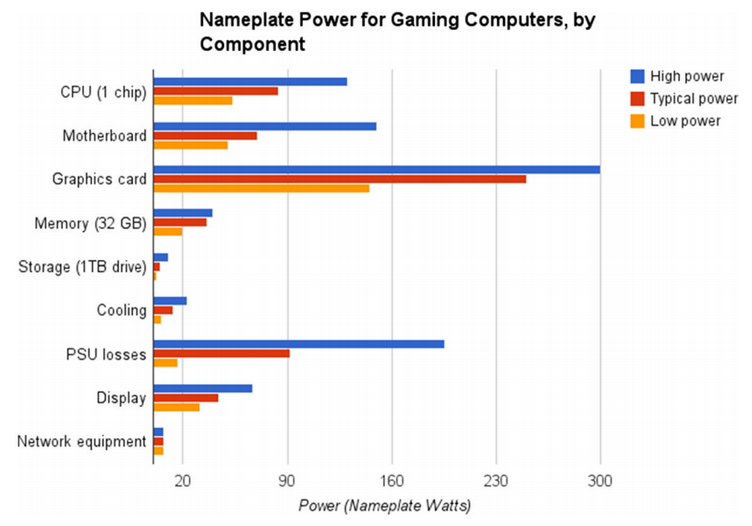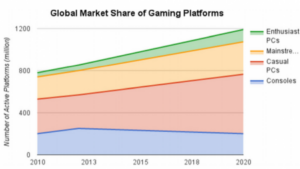Gaming PCs consume roughly 75 billion kilowatt-hours per year of electricity in 2012 – 20% of global PC consumption.

Evan Mills of Lawrence Berkeley National Laboratory and Nathaniel Mills of GreeningTheBeast.com just published a study, in the journal, Energy Efficiency, that presents a novel analysis of the energy use of gaming PCs. We (Jon Peddie Research) were able to assist him by providing marketing data and some background information on the gaming markets.
 Adapted from Open Gaming Alliance 2015: Business Wire 2012About one billion people around the world today engage in digital gaming. Gaming is the most energy-intensive use of desktop computers, and the high-performance “racecar” machines built expressly for this purpose comprise the fastest growing type of gaming platform.
Adapted from Open Gaming Alliance 2015: Business Wire 2012About one billion people around the world today engage in digital gaming. Gaming is the most energy-intensive use of desktop computers, and the high-performance “racecar” machines built expressly for this purpose comprise the fastest growing type of gaming platform.
Mills found enormous performance-normalized variations in power ratings among the gaming computer components available on today’s market. For example, central processing units vary by 4.3-fold, graphics processing units 5.8-fold, power supply units 1.3-fold, motherboards 5.0-fold, RAM 139.2-fold, and displays 11.5-fold. Similarly performing complete systems with low, typical, and high efficiencies correspond to approximately 900, 600, and 300 watts of nameplate power, respectively.
While measured power requirements are considerably lower than nameplate for most components we tested–by about 50% for complete systems–the bottom-line energy use is massive compared to that of standard personal computers.
Based on our actual measurements of gaming PCs with progressively more efficient component configurations, together with market data on typical patterns of use, Mills estimates that the typical gaming PC (including display) uses about 1400 kilowatt-hours of electricity per year. The energy use of a single typical gaming PC is equivalent to the energy use of 10 game consoles, 6 conventional desktop computers, or 3 refrigerators. Depending on local energy prices, it can cost many hundreds of dollars per year to run a gaming PC.
While gaming PCs represent only 2.5% of the global installed personal computing equipment base, our initial scoping estimate suggests that gaming PCs consumed roughly 75 billion kilowatt-hours per year of electricity globally in 2012, or approximately 20% of all personal desktop computer, notebook, and console energy usage combined. For context, this corresponds to about $10 billion per year in energy expenditures, or the equivalent electrical output of 25 typical electric power plants.
Given market trends and projected changes in the installed base, Mills estimates that this energy consumption will more than double by the year 2020 if the current rate of equipment sales is unabated and efficiencies are not improved. Although they will represent only 10% of the installed base of all types of gaming platforms globally in 2020, relatively high unit energy consumption and high hours of use will result in gaming computers being responsible for 40% of overall gaming energy use.
 The display takes much less power than a gaming graphics card, but the calculations are based on an assumption of a single display.
The display takes much less power than a gaming graphics card, but the calculations are based on an assumption of a single display.
This significant energy footprint can be reduced by more than 75% with premium efficiency components and operations, while improving reliability and performance. This corresponds to a potential savings of approximately 120 billion kilowatt-hours or $18 Billion per year globally by 2020.
There is a significant lack of current policies to achieve such improvements, and very little guidance is available to help consumers make energy efficient choices when they purchase, upgrade, and operate their gaming PCs. Key opportunities include product labeling, utility rebates, and minimum efficiency standards.
You can download the report from here: http://tinyurl.com/puc29lu
Dr. Jon Peddie.
Analyst Comment
I was surprised to see how little (relative) power is taken by current displays compared to other components, given how much much emphasis has been put on Energy Star and all the other low power requirements and labelling, although the calculations are done on the basis of a single display. Having said that, a number of gamers using multiple displays are also likely to have multiple graphic displays. As I pointed out in a Display Daily a short while ago, the trends to HDR, WCG and UltraHD all will tend to push power consumption up. Is Power the Elephant in the Room for Better Pixels? (BR)

